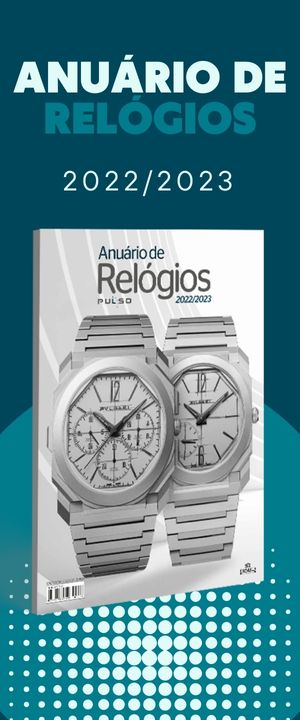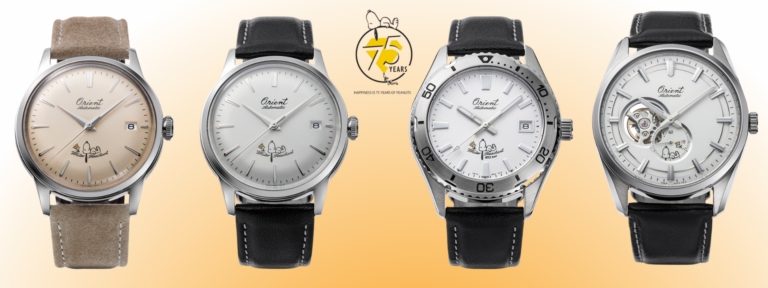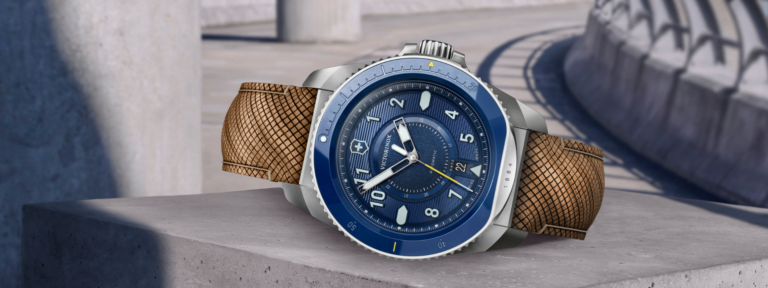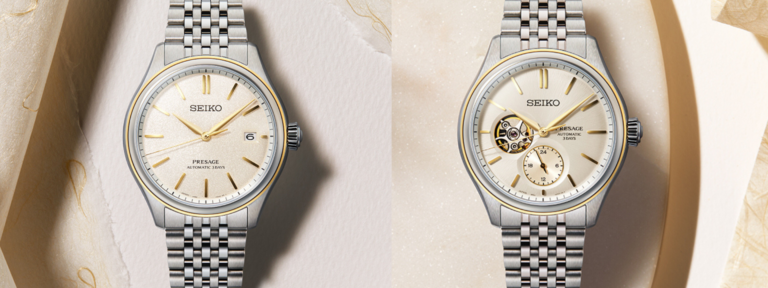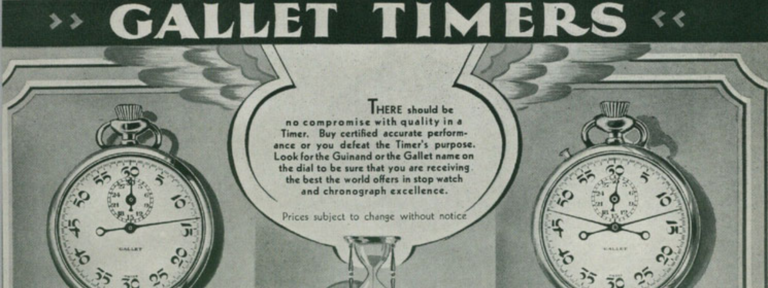The world’s fastest triple-axis regulating mechanism
THREE WORLD FIRSTS
- First-ever collaboration between legends Eric Coudray and Kari Voutilainen.
- Proprietary new ‘TriAx’ mechanism features 3 axes revolving at different speeds and on different planes, in record-breaking 8 seconds, 12 seconds and 20 seconds.
- Unique combination of Potter escapement, hemispherical balance and helical hairspring.
What if you could harness the raw power and spectacle of a thunderbolt within a watch?
Meteorological science tells us that when cold and warm currents meet, all manner of dramatic weather ensues. Storms, freak atmospheric conditions and even tornadoes have been known to follow. So when two very different master watchmakers come together – one a legendary innovator from the Vallée de Joux known for his unorthodox, jaw-dropping complications, the other a famed perfectionist and acclaimed pillar of traditional craft based in Môtiers – look out for lightning on the horizon.
Presenting the Legacy Machine Thunderdome, jointly signed by Eric Coudray and Kari Voutilainen.
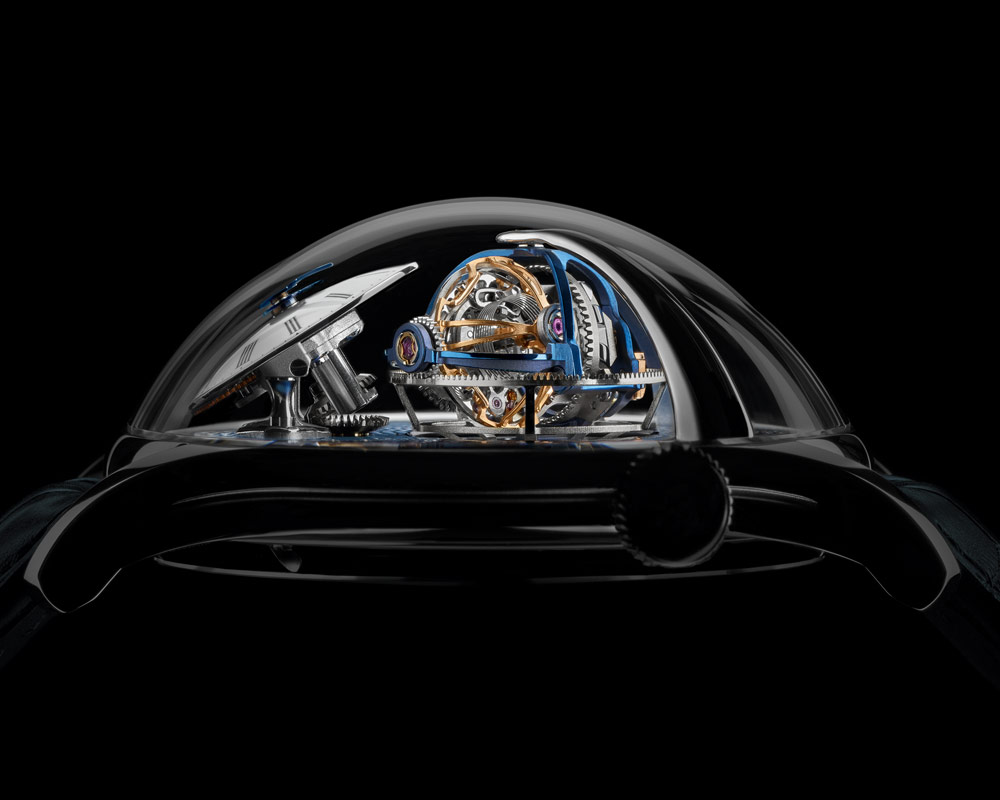
Rising above a sea of blue guillochage is a rotating spherical mass of gears, pinions and cages. Somehow, from this chaos of motion, order is extracted. Time is indicated on an inclined dial of stretched lacquer, proving that even the wildest horological whirlwinds can be tamed into the logic of hours and minutes.
MB&F founder Maximilian Büsser says, “One of the many things that makes me incredibly happy about this piece is that we got to bring together two people I adore in this industry; who are incredibly talented, have completely different styles and personalities, and have never had the chance to work with each other”.
Once taken, such chances can reshape entire landscapes. MB&F’s only directive to Eric Coudray initially was to “make the craziest, most cinematic three-axis tourbillon ever.” Having been given free rein to create, Coudray built something that was entirely new in his experience: a mechanism that goes beyond the tourbillon, the proprietary new MB&F ‘TriAx’.
The new TriAx mechanism, as showcased in Legacy Machine Thunderdome, fulfils MB&F’s directive to Eric Coudray in spectacular fashion. The triple-axis rotating escapement has a stripped-down construction that transgresses both tradition and modern convention. Instead of the rational (and cumbersome) system that associates one cage with each rotational axis, the TriAx defies logic with a three-axis, two-cage configuration that allows for unprecedented visibility of the Thunderdome’s beating, whirling heart.
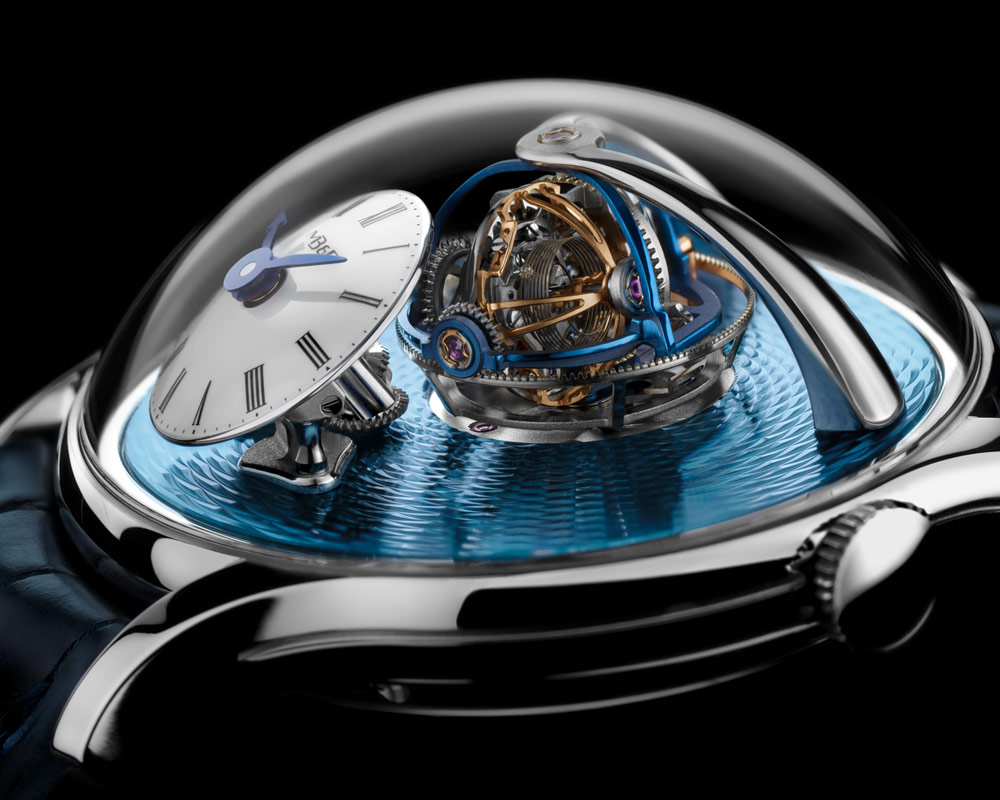
In a second stroke of whirlwind audacity from Coudray – whose name is practically synonymous with audacious watchmaking in the 21st century – the TriAx mechanism of LM Thunderdome uproots our most familiar notions of watchmaking escapements. Controlling the rate at which energy escapes from the barrel is the unusual Potter escapement, which utilises a fixed escape wheel in place of the mobile escape wheels seen in virtually every type of modern rotating escapement. The fixed escape wheel of the Potter escapement – named for 19th-century watchmaker and inventor Albert H. Potter – allows for higher rotational speeds in such a mechanism.
Integrating a fixed escape wheel within a tri-axial rotating mechanism is something that has never been done before, but LM Thunderdome achieves this, and for good reason. The high-speed rotation consumes energy voraciously, with the innermost structure completing one turn in 8 seconds, the intermediate cage rotating once every 12 seconds, and the outermost cage making one full rotation every 20 seconds.
An additional advantage of the Potter escapement is that it frees up more space for the balance and hairspring, allowing to better admire another completely novel development: the balance of LM Thunderdome takes a hemispherical form, wrapping around the helical hairspring for an unprecedented configuration of regulating organ in both modern and classical watchmaking.
Even for a seasoned watch connoisseur, deeply familiar with multi-axis tourbillons over the 15 years since this type of mechanism debuted on the horological scene, Legacy Machine Thunderdome is an eye-opener. Not only is it faster, its components whirring past at dizzying speeds – it is larger, thanks to the offset axis of the outermost cage that increases the overall displacement of the balance, and it is showcased like no other. The pronounced arch of the sapphire crystal dome allows Eric Coudray’s opus to sit fully above the dial plate, visible from all sides.
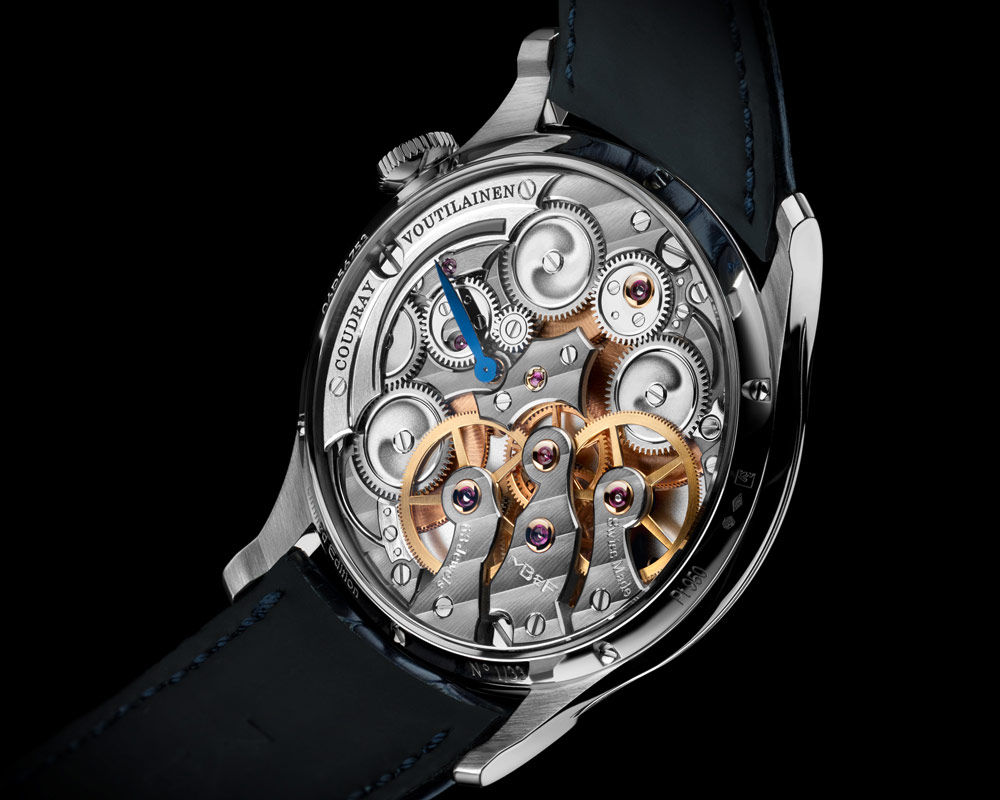
As difficult as it may be to tear your eyes from the dial-side spectacle, the reverse of the LM Thunderdome engine is equally rewarding. The manual-winding, triple-barrel movement may have been technically conceived by Eric Coudray, but its aesthetics are fully Kari Voutilainen. Countless sessions passed between the two watchmakers until the untrammelled dynamism of Coudray’s engine design took on classically elegant forms. Smoothly rounded bridges, incorporating sharp hand-bevelled internal angles and mirrored curves suggest a deep, unyielding calm that anchors the turbulent maelstrom on the other side. For the first time in an MB&F creation, Kari Voutilainen has applied his proprietary style of finish onto the ratchet wheels. This technique imparts a serpentine shimmer to the circular surface, catching the light in sigmoid waves. This technique is a closely guarded secret in the Voutilainen workshops, requiring years of experience and special tools to execute.
The LM Thunderdome is launched in two limited editions:
- 33 pieces in platinum 950, with a light-blue guilloché dial plate;
- 10 pieces in tantalum commemorating the 40th anniversary of Asia-Pacific retail group The Hour Glass, with five pieces bearing a dark-blue guilloché dial and five pieces with an inlaid aventurine dial.
LM Thunderdome in detail
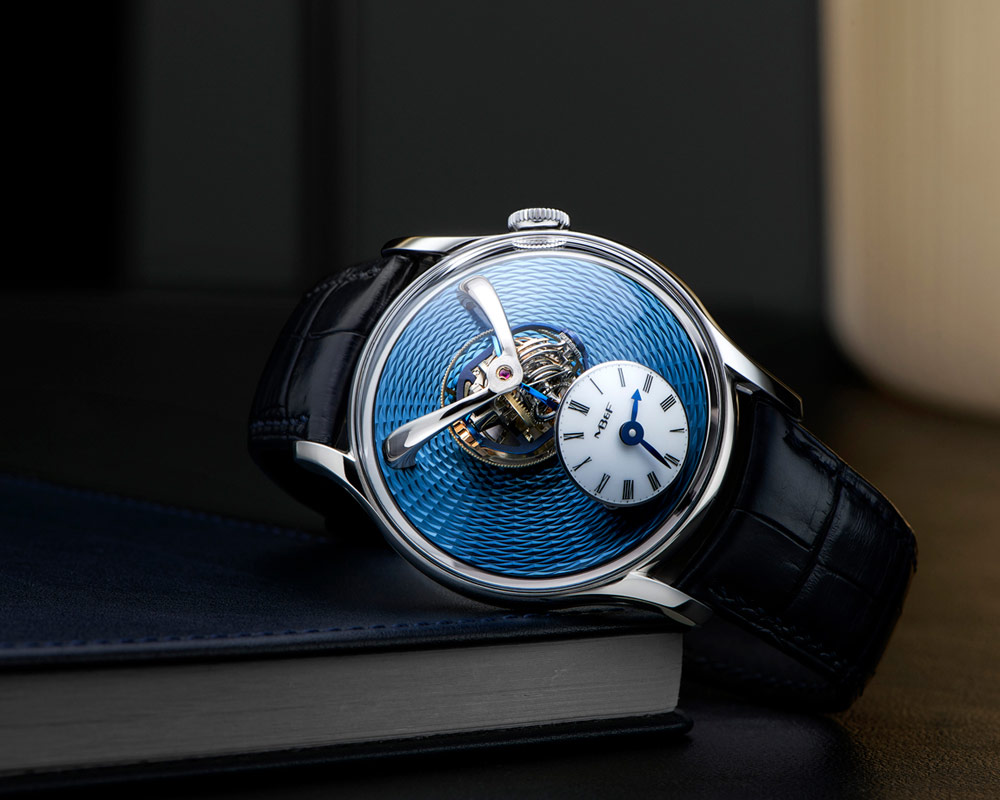
About the LM Thunderdome engine
The MB&F Legacy Machine Thunderdome is the culmination of four years of development, an unprecedented collaboration between two of the most admired horological minds today, Eric Coudray and Kari Voutilainen. While the technical construction originated with Coudray, it was Voutilainen who translated the mechanism into the aesthetically refined movement that inhabits LM Thunderdome.
Though the latter task may seem straightforward compared to technical development, it actually entails a far greater level of difficulty than is implied. The complex and delicate relationship between the 413 components of the LM Thunderdome engine makes every micro-adjustment an extended exercise in mechanical reconfiguration. With a movement diameter of only 35mm, proportionate design is exponentially emphasised and there is far less margin for error. A bridge that is even one single millimetre too wide, or a pinion moved just a few micrometres to either side, would immediately stand out, glaringly out of place.
Says Voutilainen, “In such a complex project, with so many different considerations, I chose the traditional method of hand-drawing the movement rather than working with computer software. It allowed me to have a much better feel for the proportions and the choices that needed to be made about aesthetics and function.”
Appearing to hover above the dial plate of Legacy Machine Thunderdome is the ‘TriAx’, a highly sophisticated multi-axis rotating escapement that is completely novel even in Eric Coudray’s unmatched oeuvre of similar mechanisms.
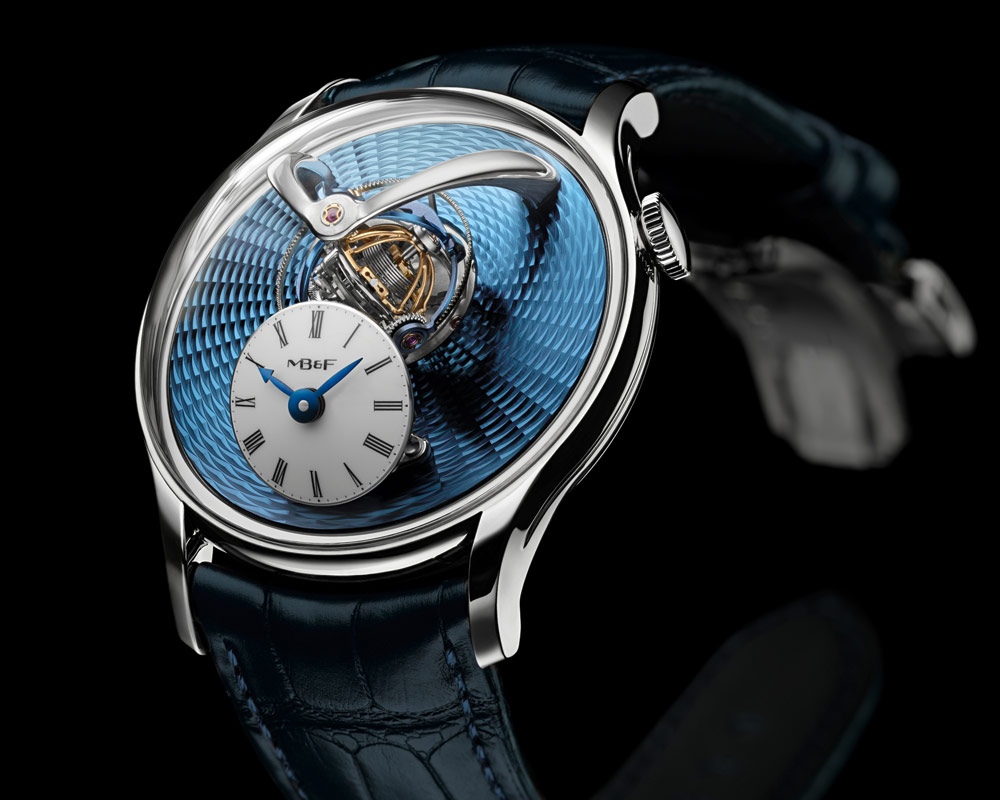
There are three axes rotating at different speeds and on different planes, starting with the innermost axis that makes one complete turn in 8 seconds. The next axis of rotation is canted at right angles to the first, and makes one complete turn in 12 seconds. The outermost axis of rotation is canted at right angles to the second, and makes one complete turn in 20 seconds. This gives LM Thunderdome the distinction of possessing the fastest combined rotation in the category of multi-axis regulating mechanisms.
Additionally, the last axis of rotation is excentric relative to the other two, such that the final motion of the balance wheel, when viewed in isolation, is most precisely described as an orbital tri-axial rotation.
In chronometric context, this means the LM Thunderdome engine has the largest range and fastest rate of balance positional displacement known throughout the history of watchmaking. In a rather more accessible context, this means that LM Thunderdome offers a visual spectacle that the horological world has never seen before. Existing terminology does not adequately cover the rotating mechanism of LM Thunderdome. The current separation of rotating escapements into tourbillon or karrusel categories does not work here, as Coudray’s creation incorporates key elements of both, such as the split-train energy transmission of the karrusel, and the fixed wheel of the tourbillon. Even so, these elements are configured in ways that are unfamiliar to our conventional definitions of tourbillon and karrusel. Mechanically speaking, Thunderdome stands alone.
Driving this cinematic feat of horology, which weighs close to 1g, is a manual-winding three-barrel movement with 45 hours of power reserve.
More about TriAx: a three-dimensional balance and a rare escapement
For the first time in any micro-mechanical work of horology, a hemispherical balance is used to provide inertia in the regulating organ. This completely innovative custom solution allows for the largest possible balance when combined with a cylindrical hairspring, while still maintaining a relatively compact cage (or compound cages, as the case might be).
Cylindrical hairsprings have been used throughout history for timepieces that prioritised isochronism and overall timekeeping performance, since the highly uniform breathing of a cylindrical hairspring is less likely to cause timekeeping anomalies even in a wide range of disruptive environmental conditions.
Pioneering a three-dimensional balance might be considered by even the most ambitious watchmakers as enough of a challenge, without the extra step of planting it in the middle of a multi-axis rotating mechanism. How does one adjust a balance that takes a different position in all three dimensions every second?
Even state-of-the-art laser measuring instruments were baffled by the continuously shifting balance and its enclosing rotating cages. MB&F furthered the known applications of this laser technology by shifting the beam frequency entirely into the infra-red range (thus avoiding any misreadings caused by the visible range of the beam interacting with the polished components) and developing a system of taking discrete readings at specific intervals over a period of time. This, in addition to the combined experience and skill of Eric Coudray and the MB&F watchmakers, allowed the LM Thunderdome balance to be adjusted with efficiency and precision.
The key to the high-speed rotation of TriAx at the heart of LM Thunderdome is a little-known variant of escapement, first proposed by 19th-century American watchmaker and inventor Albert H. (not Harry) Potter as a tourbillon modification. Instead of driving the escape wheel, via its pinion, around a fixed fourth wheel, he made the escape wheel the fixed wheel, and altered the geometry of the escape lever accordingly. This, he correctly theorised, would allow blindingly fast tourbillon rotational speeds.
In the TriAx mechanism of LM Thunderdome, the Potter escapement is modified yet further. Instead of a fixed escape wheel with externally oriented teeth, co-axial to the balance, Thunderdome uses a fixed escape wheel with inverted teeth, co-planar to the lever fork. Only once has this configuration been seen in modern horology, and only in a single-axis tourbillon, never before in a multi-axis mechanism. There was no rulebook or established precedent, so TriAx created its own. These are all firsts for MB&F, and more significantly, they are firsts in the horological world.
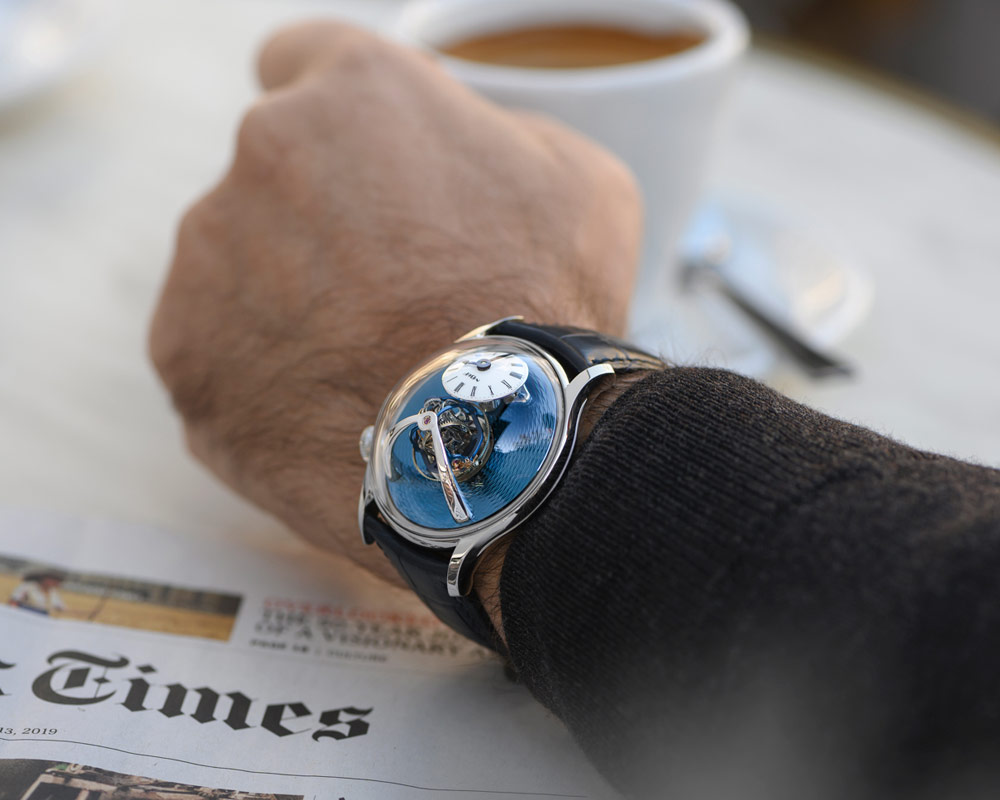
Exceptional finish
Because an exceptional movement deserves exceptional levels of finish, Kari Voutilainen consented — for the first time in an MB&F creation — to apply his own proprietary finishing technique on the ratchet wheels. This finish imparts a sheen that appears almost uniformly sandblasted, but reflects direct light in deeply curved sigmoid waves.
“Not even someone with years and years of finishing experience could replicate this finish,” says Voutilainen. “Not without specific training, specific tools and specific techniques.” Needless to say, these specific things will remain unspecified by Voutilainen, save for highly favoured and trusted finishing experts in his workshop.
The rest of the Legacy Machine Thunderdome engine features superlative hand finishing throughout, at the highest level of 19th-century style. Sharp internal angles, unachievable by machines, are bevelled and polished by hand. The softly luminous Geneva waves characteristic of Voutilainen are applied by hand, as are the frosting and engraving on the power-reserve indication. Surrounding the multi-axis rotating escapement is a guilloché dial plate, which is also created by Kari Voutilainen in Comblémine, his dial factory.
MB&F and The Hour Glass
The core philosophy of MB&F is contained entirely within its name — Maximilian Büsser & Friends. Independent watchmaking was in its infancy when Max Büsser founded his own company 15 years ago, and support from key retail partners such as The Hour Glass was essential for survival.
Büsser says, “The early days of MB&F were a personal and professional challenge the likes of which I had never faced before. If not for Michael Tay of The Hour Glass and his belief in this crazy dream of mine, it’s possible that Horological Machine Nº1 might have never existed.”
Founded four decades ago in the world’s most sophisticated and concentrated watch market, Singapore, The Hour Glass retail group is acknowledged to be a driving force within the Asia-Pacific horological scene. Its operations span the region and its boutiques are frequently at the centre of the local watch community. Says Michael Tay, Group Managing Director of The Hour Glass, “I first met Max in Singapore in November 1998 and it is one of those rare relationships in my life where what started as a professional partnership has, over the past two decades, transformed into one of a lifelong friendship. I value Max because he is one of the few visionaries in the universe of contemporary horology and – of more significance to me – is both reliable and consistent in his approach to his brand and business. We’re extremely proud to have this opportunity to launch with MB&F this commemorative edition. This was a project that was first discussed with both Max and Eric Coudray as far back as 2012 and has taken the better part of 7 years to realise. It is definitely one for the history books.”
More about Eric Coudray and Kari Voutilainen
Eric Coudray is descended from a long line of watchmakers. Although he distinguished himself in his early professional years by restoring antique timepieces, his name first came to global prominence while he was employed by legendary watch brand Jaeger-LeCoultre, where he led prestigious projects such as the first modern minute repeater from the manufacture, housed in their iconic Reverso.
He developed the Jaeger-LeCoultre Gyrotoubillon, one of the world’s first multi-axis tourbillons, which was hailed a milestone of modern horology when it debuted in 2004. His follow-up work on the Jaeger-LeCoultre Reverso Gyrotourbillon II incorporated a helical hairspring for improved chronometry. The watch was subsequently awarded second prize at the 2009 Concours International de Chronométrie (with the first prize also taken by Jaeger-LeCoultre). His experience with this visually stunning mechanism brought him to independent watch brand Cabestan, where he further expanded his repertoire of multi-axis rotating escapements. Coudray is currently part of a specialist team at TEC Ebauches, a high-complication thinktank and movement supplier based in the Vallée de Joux.
Part of the fascination that Coudray and his creations induce in watch enthusiasts stems from his unorthodox approach to his métier and unique personal style. Such is Coudray’s stature amongst the international cognoscenti of horology that members of this community frequently approach Coudray at industry expositions and trade fairs to express admiration for his work.
Equal in repute, though opposite in approach, is Finnish watchmaker Kari Voutilainen, whose company is based in the small Swiss village of Môtiers. Like Coudray, Voutilainen’s early career was characterised by restoration work. It was while he was employed in the restoration department of Fleurier watch company Parmigiani that Voutilainen became known for his outstanding talent and was involved in the restoration of some of the world’s rarest examples of haute horlogerie.
Later, when he established his watch company, Voutilainen was able to draw on this experience to create his own timepieces. His watches, notably the highly successful Vingt-8, are just as acclaimed for their extreme aesthetic refinement as they are for their interpretation of Breguet’s natural escapement. Voutilainen has lent his much sought-after expertise to selected companies, and his name is inextricably associated with the MB&F Legacy Machine collection, which has carried his signature since its debut in 2011. Unmatched levels of hand-finishing are the hallmark of a Voutilainen watch, with a distinctive softness and luminosity to the final effect which sets them apart from the sharper, brighter finishes that define the industry standard. Voutilainen’s passion for decorative techniques has led him to create some of the most beautiful unique timepieces seen in recent years, in conjunction with independent artisanal craftsmen. Recognition has come in the form of several industry accolades, including multiple awards from the Grand Prix d’Horlogerie de Genève.
TECHNICAL SPECIFICATIONS – LM THUNDERDOME
Two Limited Editions:
- Limited edition of 33 pieces in platinum 950, with light-blue guilloché dial;
- Limited edition of 10 pieces in tantalum for The Hour Glass (5 pieces with an aventurine dial and 5 pieces with a dark-blue guilloché dial).
Engine
- Movement developed for MB&F by Eric Coudray and Kari Voutilainen.
- Regulating mechanism featuring 3 fast rotation axes revolving at different speeds and on different planes. The rotation speeds of the axes starting from the centre are respectively 8 seconds, 12 seconds and 20 seconds. The combined weight of the multi-axis mechanism is nearly 1g.
- Manual winding with three mainspring barrels.
- Bespoke hemispherical 10mm balance wheel with traditional regulating screws and helical hairspring, visible on top of the movement.
- Superlative hand finishing throughout respecting 19th-century style; bevelled internal angles highlighting hand craft; polished bevels; Geneva waves; hand-made engravings.
- Power reserve: 45 hours
- Balance frequency: 3 Hz / 21,600bph
- Number of components: 413 Number of jewels: 63
Functions & indications
- Hours and minutes displayed on a 58° vertically tilted dial
- Power reserve indicator on the back of the movement
Case
- Material: launch edition in platinum 950 and The Hour Glass editions in tantalum
- Dimensions: 44mm x 22.2 mm
- Number of components: 20
- Water resistance: 30m / 90′ / 3ATM
Sapphire crystals
- Sapphire crystals on top and display back treated with anti-reflective coating on both faces.
Strap & buckle
- Blue hand-stitched alligator strap with platinum or tantalum folding buckle matching the case.
‘FRIENDS’ RESPONSIBLE FOR LM THUNDERDOME
Concept: Maximilian Büsser / MB&F
Product design: Eric Giroud / Through the Looking Glass
Technical and production management: Serge Kriknoff / MB&F
Movement development: Eric Coudray and Arnaud Faivre / TEC Ebauches and MB&F
Movement design and finish specifications: Kari Voutilainen
R&D: Ruben Martinez, Simon Brette and Thomas Lorenzato / MB&F
Decoration of the guilloché dial plate / ratchet / crown’s wheels: Kari Voutilainen
PVD-treatment: Pierre-Albert Steinmann / Positive Coating
Aventurine dial (Limited edition for The Hour Glass): LM Cadrans
Case: Riccardo Pescante / Les Artisans boitiers and for the limited edition for The Hour Glass: Aurélien Bouchet / AB PRODUCT
Movement assemblage: Didier Dumas, Georges Veisy, Anne Guiter, Emmanuel Maître, and Henri Porteboeuf / MB&F
After-sales service: Thomas Imberti / MB&F
Quality control: Cyril Fallet / MB&F
Dial – ébauche: Hassan Chaïba and Virginie Duval / Les Ateliers d’Hermès Horloger
Buckle: Nathalie Guilbaud / Cendres et Métaux Lux and G&F Châtelain
Hands: Pierre Chillier and Isabelle Chillier / Fiedler
Strap: Multicuirs
Presentation box: Olivier Berthon / Soixante et onzeProduction logistics: David Lamy, Isabel Ortega/ MB&F
Marketing & Communication: Charris Yadigaroglou, Virginie Toral, Juliette Duru and Arnaud Légeret / MB&F
Sales: Thibault Verdonckt, Anna Rouveure, Virginie Marchon and Jean-Marc Bories / MB&F
Design graphique: Samuel Pasquier / MB&F, Adrien Schulz and Gilles Bondallaz / Z+Z
Photographies du produit: Maarten van der Ende, Laurent Xavier Moulin and Alex Teuscher / Alex Stephen Teuscher photography
Portrait Photographies: Régis Golay / Federal
Webmasters: Stéphane Balet / Nord Magnétique, Victor Rodriguez and Mathias Muntz / Nimeo
Film: Marc-André Deschoux / MAD LUXTexts: Suzanne Wong / Worldtempus
MB&F – Genesis of a Concept Laboratory
2019 marked the 14th year of hyper-creativity for MB&F, the world’s first-ever horological concept laboratory. With 17 remarkable calibres forming the base of the critically acclaimed Horological and Legacy Machines, MB&F is continuing to follow Founder and Creative Director Maximilan Büsser’s vision of creating 3-D kinetic art by deconstructing traditional watchmaking.
After 15 years managing prestigious watch brands, Maximilian Büsser resigned from his Managing Director position at Harry Winston in 2005 to create MB&F – Maximilian Büsser & Friends. MB&F is an artistic and micro-engineering laboratory dedicated to designing and crafting small series of radical concept watches by bringing together talented horological professionals that Büsser both respects and enjoys working with.
In 2007, MB&F unveiled its first Horological Machine, HM1. HM1’s sculptured, three-dimensional case and beautifully finished engine (movement) set the standard for the idiosyncratic Horological Machines that have followed – all Machines that tell the time, rather than Machines to tell the time. The Horological Machines have explored space (HM2, HM3, HM6), the sky (HM4, HM9), the road (HM5, HMX, HM8) and water (HM7).
In 2011, MB&F launched its round-cased Legacy Machine collection. These more classical pieces – classical for MB&F, that is – pay tribute to nineteenth-century watchmaking excellence by reinterpreting complications from the great horological innovators of yesteryear to create contemporary objets d’art. LM1 and LM2 were followed by LM101, the first MB&F Machine to feature a movement developed entirely in-house. LM Perpetual, LM Split Escapement and LM Thunderdome broadened the collection further. 2019 marked a turning point with the creation of the first MB&F Machine dedicated to women: LM FlyingT. MB&F generally alternates between launching contemporary, resolutely unconventional Horological Machines and historically inspired Legacy Machines.
As the F stands for Friends, it was only natural for MB&F to develop collaborations with artists, watchmakers, designers and manufacturers they admire.
This brought about two new categories: Performance Art and Co-creations. While Performance Art pieces are MB&F machines revisited by external creative talent, Co-creations are not wristwatches but other types of machines, engineered and crafted by unique Swiss Manufactures from MB&F ideas and designs. Many of these Co-creations, such as the clocks created with L’Epée 1839, tell the time while collaborations with Reuge and Caran d’Ache generated other forms of mechanical art.
To give all these machines an appropriate platform, Büsser had the idea of placing them in an art gallery alongside various forms of mechanical art created by other artists, rather than in a traditional storefront. This brought about the creation of the first MB&F M.A.D.Gallery (M.A.D. stands for Mechanical Art Devices) in Geneva, which would later be followed by M.A.D.Galleries in Taipei, Dubai and Hong Kong. There have been distinguished accolades reminding us of the innovative nature of MB&F’s journey so far. To name a few, there have been no less than 5 Grand Prix awards from the famous Grand Prix d’Horlogerie de Genève: in 2019, the prize for Best Ladies Complication went to the LM FlyingT, in 2016, LM Perpetual won the Grand Prix for Best Calendar Watch; in 2012, Legacy Machine No.1 was awarded both the Public Prize (voted for by horology fans) and the Best Men’s Watch Prize (voted for by the professional jury). In 2010, MB&F won Best Concept and Design Watch for the HM4 Thunderbolt. In 2015 MB&F received a Red Dot: Best of the Best award – the top prize at the international Red Dot Awards – for the HM6 Space Pirate.

